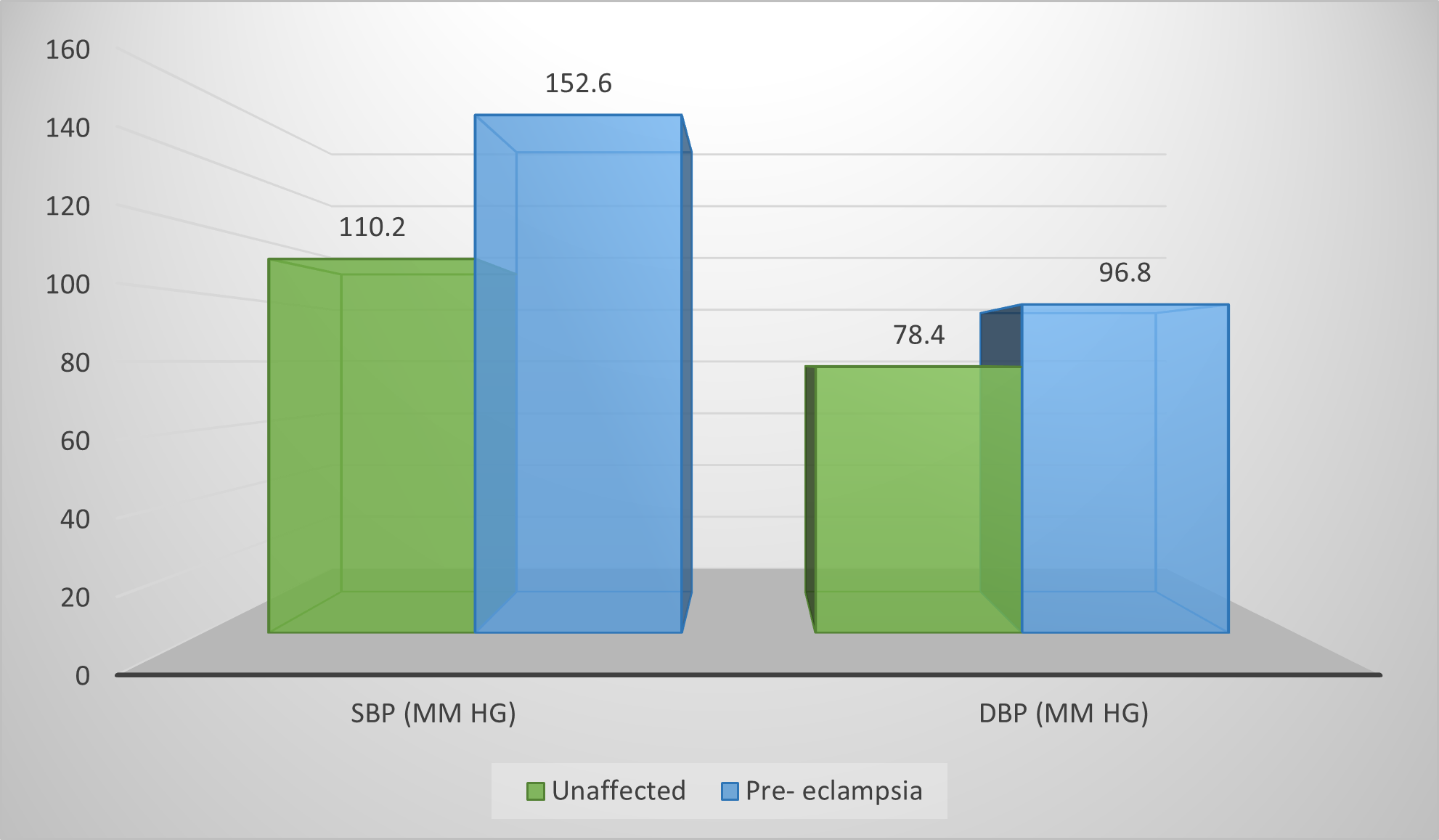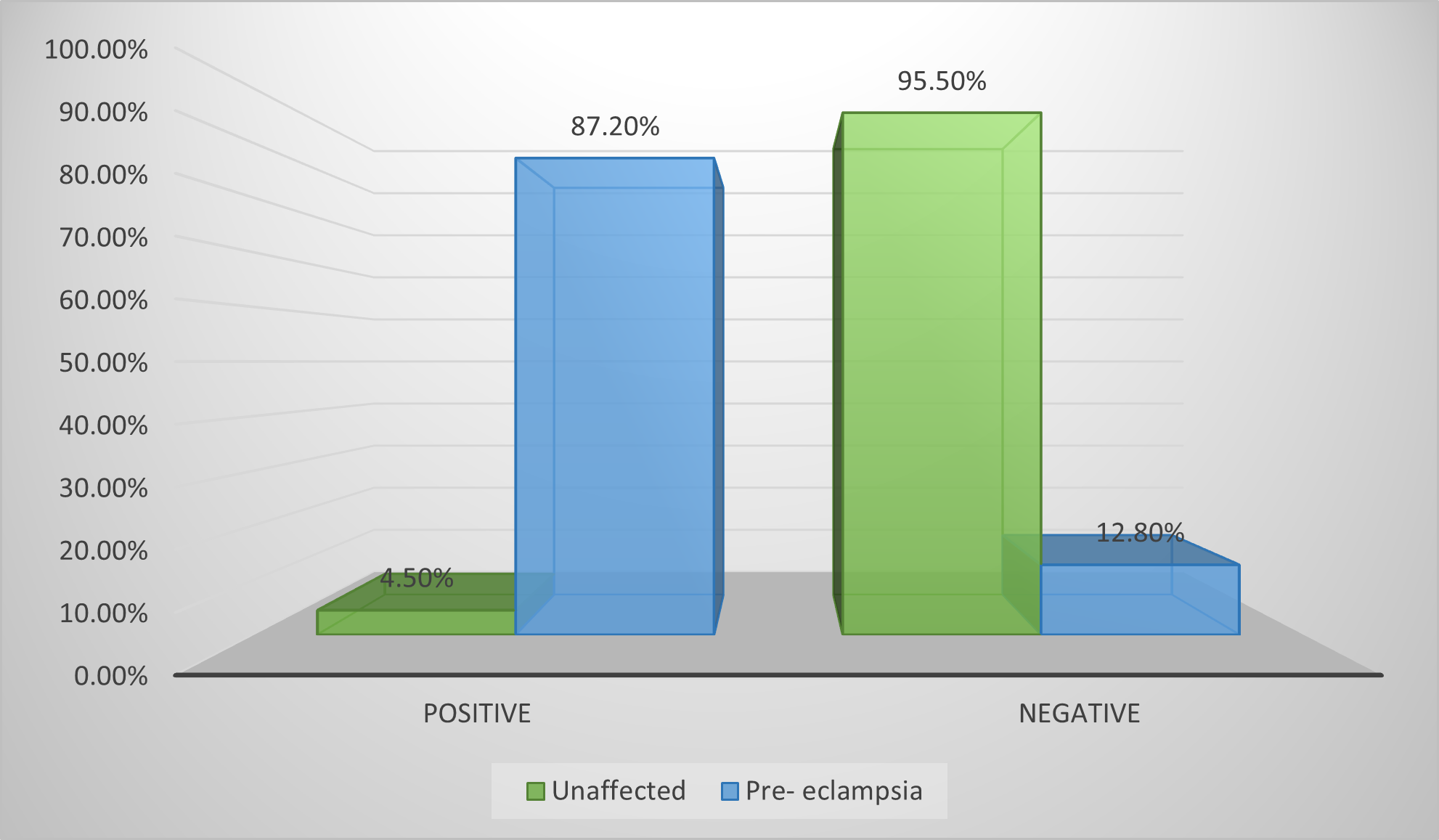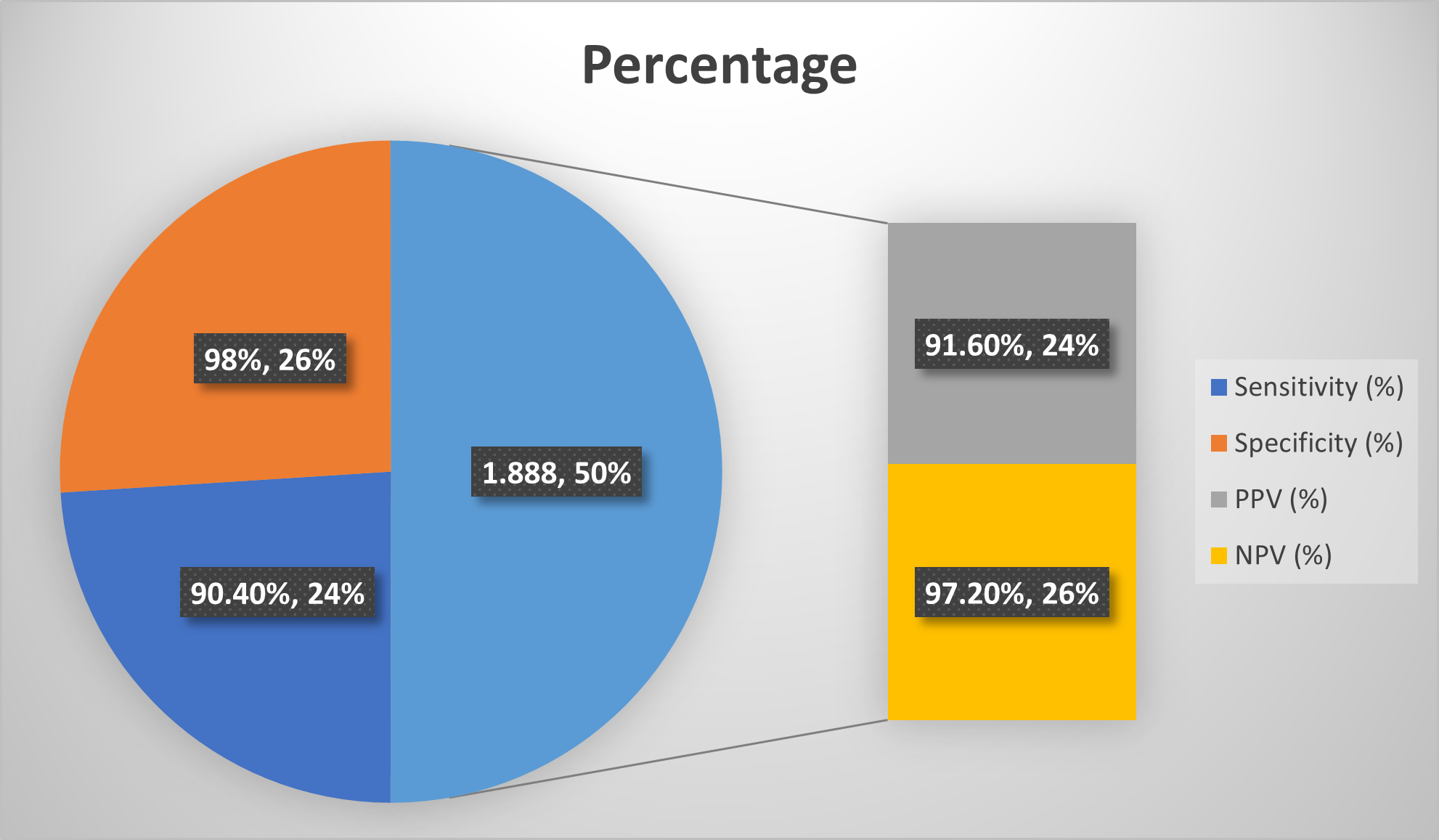The aim of this paper is to diagnose pre-eclampsia with spot urine albumin-creatinine ratio (ACR). Our study comprised of one hundred ten pregnancies within 20-28 weeks of gestation. Spot mid- stream urine sample was collected from all pregnant females and urine ACR estimation was done using immunoturbidimetric microalbumin method and modified Jaffe’s method for creatinine estimation. We found sensitivity of 90.4%, specificity of 98%, PPV of 91.6% and NPV of 97.2%. Systolic blood pressure in unaffected subjects was 110.2 mm Hg and in pre- eclamplsia was 152.6 mm Hg. Diastolic blood pressure in unaffected subjects was 78.4 mm Hg and in pre- eclamplsia was 96.8 mm Hg. In unaffected subjects, 4.5% showed positive test and 95.5% showed negative test. In pre- eclampsia subjects, 87.2% showed positive test and 12.8% showed negative test. Mann Whitney U test showed significant difference between two (Significant, P< 0.05). It has been observed that the role of urine albumin creatinine ratio in detection of Pre-eclampsia is evident. A higher sensitivity and specificity revealed its usefulness in early detection.
Pre-eclampsia (PE) is defined as a pregnancy-specific syndrome of reduced organ perfusion secondary to vasospasm and endothelial dysfunction. It is considered to be major reason for maternal mortality. It forms 12-20% of pregnancy related deaths [1] The number of cases in developing countries is on rise and it is approximately 4-19%. Pre- existing cardiovascular diseases (CVDs) may increase the prevalence of Pre-eclampsia (PE) in females [2,3].
The diagnosis of Pre-eclampsia is made with the presence of proteinuria > 300 mg /24hours and occurrence of blood pressure is at or >140/90 mmHg occurring on two occasions at least at interval of six hours [4]. Severe forms of preeclampsia can be complicated by renal, cardiac, pulmonary, hepatic, and neurological dysfunction; hematologic disturbances; fetal growth restriction; stillbirth; and maternal death [5]. It is regarded as hypertensive disorders of pregnancy. There are few risk factors for Pre-eclampsia such as obesity with BMI >30, diabetes mellitus, maternal age >35 years, chronic hypertension, chronic kidney disease (CKD), obstructive sleep apnea, pregestational diabetes, systemic lupus erythematosus (SLE) etc [6].
The pathogenesis of Pre-eclampsia occurs in two stages. The first stage consists of defective invasion of the deciduas by the fetal trophoblasts along with local placental hypoxia [7]. The second stage is characterized by liberation of placental blood-related components into the maternal circulation and aberrant expression of angiogenic, anti-angiogenic and pro-inflammatory factors [8]. The important factor is albumin which play an important role in diagnosis [9]. Patients with Pre-eclampsia shows microalbuminuria hypothesizing that the gross proteinuria stage is followed by the microalbuminuria stage. This test needs to wait for atleast 24 hours. Alternative methods to this method are dipstick and spot urinary protein: creatinine ratio, urine albumin-creatinine ratio.10 Considering this, the present study was attempted to determine cases of pre-eclampsia with spot urine albumin-creatinine ratio (ACR).
A detailed clinical history and physical examination was conducted. Informed written consent was obtained from study patients. Parameters such as age, BMI, parity, gestational age at delivery, mode of delivery, birth weight of neonates etc. was recorded. Subjects were routinely evaluated for blood pressure measurement and all clinical features of pre-eclampsia were recorded. Spot mid- stream urine sample was collected from all pregnant females and urine ACR estimation was done using immunoturbidimetric microalbumin method and modified Jaffe’s method for creatinine estimation. Results of study were recorded and subjected for statistical inferences using Mann Whitney U test. The level of significance was significant if p value is below 0.05.
The distribution of patients based on blood pressure parameters is given in Table 1. Significance is < 0.05, Mann Whitney U Systolic blood pressure (SBP) in unaffected subjects was 110.2 mm Hg and in pre- eclamplsia was 152.6 mm Hg. Diastolic blood pressure (DBP) in unaffected subjects was 78.4 mm Hg and in pre- eclamplsia was 96.8 mm Hg. Mann Whitney U test showed significant difference between two (\(P< 0.05\)) (Significant, Table 1, Figure 1).
| Variables | Unaffected | Pre- eclampsia | P value |
|---|---|---|---|
| SBP (mm Hg) | 110.2 | 152.6 | <0.05 |
| DBP (mm Hg) | 78.4 | 96.8 | <0.05 |

In unaffected subjects, 4.5% showed positive test and 95.5% showed negative test. In pre- eclampsia subjects, 87.2% showed positive test and 12.8% showed negative test. Mann Whitney U test showed significant difference between two (Significant, \(P< 0.05\)) (Table 2, Figure 2).
| UACR | Unaffected | Pre- eclampsia | P value |
|---|---|---|---|
| Positive | 4.5% | 87.2% | 0.05 |
| Negative | 95.5% | 12.8% | |
| Total | 100% | 100% |

A sensitivity of 90.4%, specificity of 98%, PPV of 91.6% and NPV of 97.2% was seen (Table 3, Figure 3).
| Variables | Percentage | |
|---|---|---|
| Sensitivity (%) | 90.4% | |
| Specificity (%) | 98% | |
| PPV (%) | 91.6% | |
| NPV (%) | 97.2% | |

Our study showed that systolic blood pressure was 110.2 mm Hg in unaffected subjects and 152.6 mm Hg in pre- eclamplsia. Diastolic blood pressure was 78.4 mm Hg in unaffected subjects and 96.8 mm Hg in pre- eclamplsia. A study by Mahajan et al., [14]. validated the accuracy of the spot urine ratio of albumin-creatinine in asymptomatic pregnant women comprising of 150 patients. Results demonstrated that 28 patients had high ACR value, 2.4% (3) remained normotensive while 89.3% (25) had pre-eclampsia. It was further observed that among 81.3% (122) patients that were ACR negative, 10.7% (3) patients developed pre-eclampsia. A higher sensitivity of 89.29%, specificity 97.54%, positive predictive value (PPV) of 89.29% and the negative predictive value (NPV) of 97.54% was observed with urine albumin-creatinine ratio.
We noted that 4.5% showed positive test and 95.5% showed negative test in unaffected subjects. 87.2% showed positive test and 12.8% showed negative test in pre- eclampsia subjects. We found that most of the subjects who showed UACR positive had pre-eclampsia and only few subjects remained unaffected. Sachan et al., [15] in their study evaluated the diagnostic accuracy of albumin-creatinine ratio (ACR) in woman with preeclampsia and eclampsia and examine the association between ACR and fetomaternal outcome in 30 preeclampsia (cases), 30 antepartum eclampsia (cases) and 30 normotensive pregnant women (controls). The mean urinary ACR value was \(0.103 ± 0.037\) which was significantly lower than controls. On comparing between groups, the difference was significant (\(< 0.001\)), a strong correlation between urinary ACR levels and 24 hours urinary proteins was observed.
Renal dysfunction in preeclampsia is defined as serum creatinine >1.1 mg/dl or a doubling of baseline creatinine. Renal blood flow and glomerular filtration rate are often decreased in preeclampsia [16]. Biopsy changes in these patients include diffuse fibrin deposition, endothelial swelling, loss of podocytes, and loss of capillary space (glomerular endotheliosis). Dysregulation of the glomerular filtration apparatus occurs in the setting of glomerular endotheliosis [17]. In normal pregnancy, increased tissue factor release from the maternal decidua and placenta shifts endothelial cells to a procoagulant balance. Increased pro-inflammatory cytokines in preeclampsia further stimulate tissue factor expression by endothelial cells and leukocytes [18].
The definitive treatment for preeclampsia is delivery. American College of Obstetricians and Gynecologists has recommended daily aspirin intake. The United States Preventive Services Task Force and the International Society for the Study of Hypertension in Pregnancy also recommended delivery to be the option for high-risk women after 12 weeks gestation to reduce their risk of preeclampsia [19]. Aspirin is proposed to reduce preeclampsia risk via inhibition of cyclooxygenase-1 and cyclooxygenase-2, which contribute to prostaglandin biosynthesis and subsequent endothelial dysfunction. A study by Devi et al., [20] on 400 ladies were assessed at first booking visit at 18-20 weeks. The mean age of the patients was \(20.5±0.5\) and \(24.5±0.5\) years. It was observed that the spot UACR may be a simple, convenient, and accurate indicator of significant proteinuria and future complications in women with preeclampsia with proper and intensive clinical follow up and intervention to prevent feto maternal morbidity and mortality.
